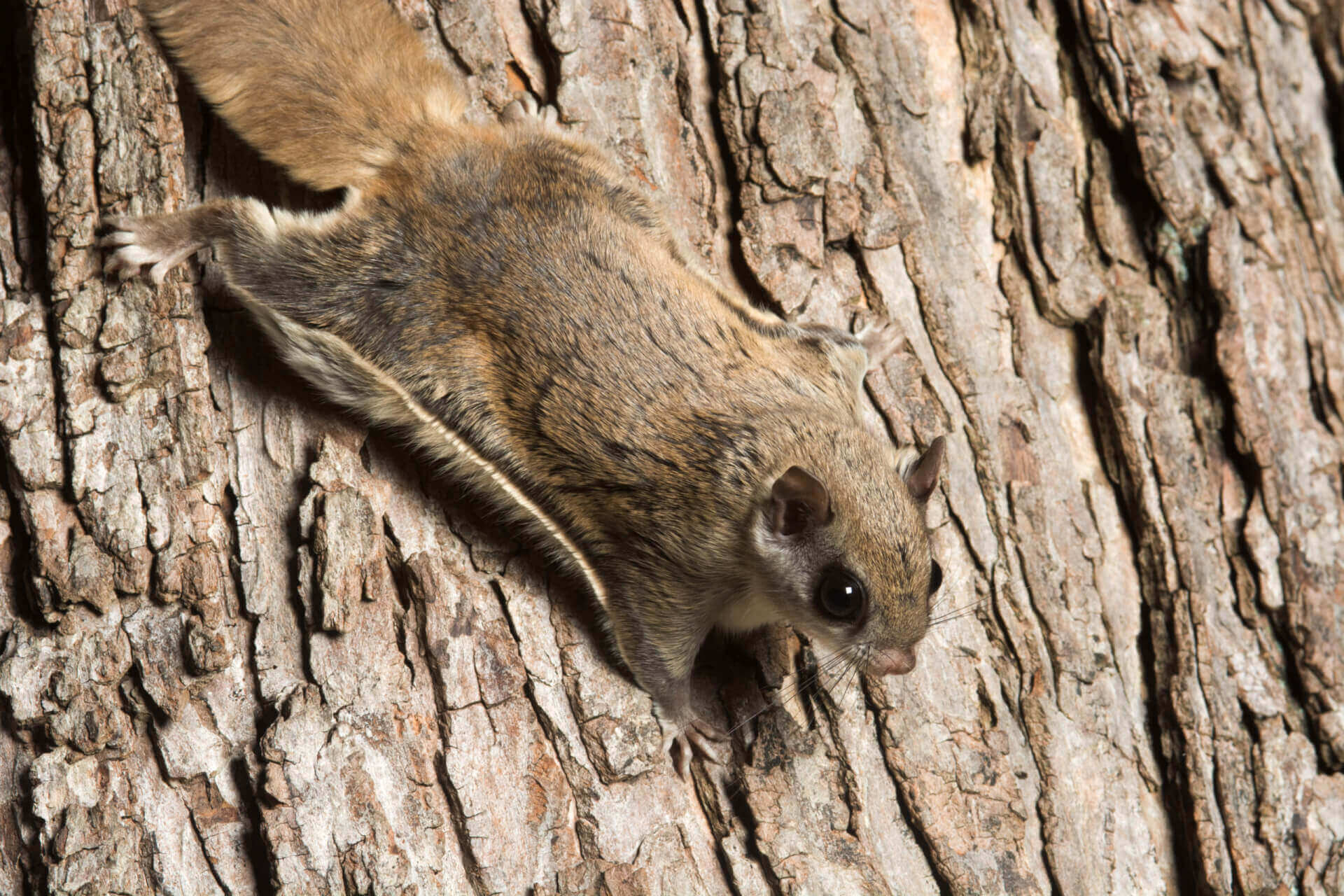Flying Squirrel Facts & Information
Everything you need to know about flying squirrels
How to Identify Flying Squirrels

Depending on the species, flying squirrels range in color from white to gray to brown with a pale belly. They should be called “gliding squirrels” because they aren’t capable of true powered flight like birds or bats. They have a special membrane between their front and back legs that allows them to glide through the air between trees. They stretch out their legs, spreading the fold of skin between the front and hind legs, to form a kind of parachute that lets them glide from branch to branch. While gliding, they are very agile and can turn and change their angle of decent. They land very lightly on all four feet. In contrast, however, flying squirrels are relatively clumsy on the ground. Adult flying squirrels are relatively small, as their head, body, and tail length totals around 10 inches. On average, they weigh anywhere from 2 to 6 ounces. Flying squirrels have large black eyes and 22 teeth.
For the southern flying squirrel, there are usually two litters each year with the young born between April-May and August-September. The gestation period is about 40 days, and they have roughly 2-6 young per litter. Alternatively, the northern flying squirrel has only one litter each year, with roughly 2-5 young born in May-June. Occasionally, there is a second litter in the autumn.
Flying squirrels become pests only when they take up residence in an attic where they can cause odor and damage with their urine, and keep people awake with their nocturnal activity. Medically speaking, however, flying squirrels are of little concern. While these squirrels have been implicated in the spread of human diseases, direct transmission is rare. Amazing to see, but not great to see in your home or business.
For the southern flying squirrel, there are usually two litters each year with the young born between April-May and August-September. The gestation period is about 40 days, and they have roughly 2-6 young per litter. Alternatively, the northern flying squirrel has only one litter each year, with roughly 2-5 young born in May-June. Occasionally, there is a second litter in the autumn.
Flying squirrels become pests only when they take up residence in an attic where they can cause odor and damage with their urine, and keep people awake with their nocturnal activity. Medically speaking, however, flying squirrels are of little concern. While these squirrels have been implicated in the spread of human diseases, direct transmission is rare. Amazing to see, but not great to see in your home or business.
How did I get flying squirrels?
Flying squirrels are known to enter homes in late fall when temperatures begin to drop. Flying squirrels often enter houses searching for warmth, a place to raise their young, and food. In addition to nesting in high places like attics, flying squirrels can also be found in external walls and between floors, using insulation as nesting material. If you have cracks or crevices, even just some loose siding, flying squirrels can make their way into your home or business. Having professional exclusion work done can help take away some entry points, but it’s probably nothing you’re doing wrong or leaving out that’s attracting them. Although if you have a bird feeder, you know they are coming from far and wide to get a taste.
Where do flying squirrels live?
The southern flying squirrel feeds on nuts, acorns, seeds, berries, some insects, and bird eggs, and will even eat meat if it’s available. Some food is stored in the nest chamber and also in tree crotches. The northern flying squirrel feeds primarily on nuts and seeds, but also eats some insects, and probably stores much food for winter use. They inhabit coniferous and mixed forests, where they prefer dead trees with numerous woodpecker’s holes for nesting, especially in stumps 6-20 feet high and those near the top. They have also been known to use the attics of buildings to build their nests.
Problems caused
Flying Squirrels can do considerable damage to exterior trim and siding since their main means of entry (besides hole and cracks) is widening to create ways to squeeze in. Once inside a home, garage, shed, or business, they can gnaw on electrical wiring and possibly cause a short or at the very least a fire hazard. They can also ruin insulation with feces and urine. Flying squirrel treatments should include exclusion work to make sure they don’t get back in once the squirrel control is complete.Not the squirrel you have?
How can I prevent flying squirrels?
To reduce the chances of finding flying squirrels in your attic, have a professional exclusion expert seal all points of entry. Be sure to have holes in roofs and loose siding fixed, and make sure all vents and openings to the chimney have fitted covers. Preventing these little rodents can be difficult. Besides sealing all possible points of entry around the house, pay close attention to small openings and cracks around doors and windows. Be sure to keep tree limbs cut back 6-8 feet from the roofline. This will help with a lot of different pests including squirrels but the fact that these squirrels can “fly”, it may not be as affective for them. At the first sign of a flying squirrel, you should call in a professional to handle it.
Why OPC?
We’re passionate about keeping squirrels out of your home or business because we live and work here – it’s our neighborhood, too. We’ve been keeping homes and businesses in Kentucky, Ohio, Illinois, Indiana, and Wisconsin safe from pests since 1972. OPC Pest Services has the experience you can trust.
Expert pest control since 1972
Quality Pro certified company
Satisfaction guarantee
Need help with flying squirrels?
GET MY QUOTE
“They always want to make sure the customer is satisfied. I have been with OPC for over 10 years. Highly recommend!”
Louisville, KY